Appearance colourless crystals Molar mass 208.24 g/mol Melting point 160.5 °C Soluble in Water | Formula PCl5 Density 2.1 g/cm³ Boiling point 166.8 °C | |
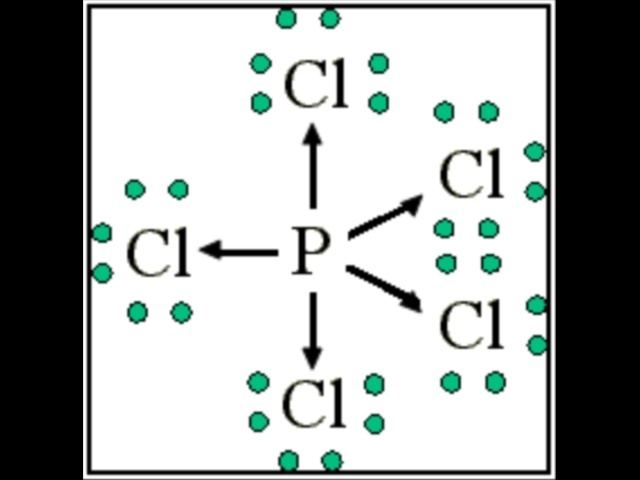 | ||
Related phosphorus pentahalides Related compounds IUPAC ID Phosphorus(V) chloride, Phosphorus pentachloride | ||
Chemistry molecular structure 34 of 45 s p3 d hybridization phosphorus pentachloride pcl5
Phosphorus pentachloride is the chemical compound with the formula PCl5. It is one of the most important phosphorus chlorides, others being PCl3 and POCl3. PCl5 finds use as a chlorinating reagent. It is a colourless, water- and moisture-sensitive solid, although commercial samples can be yellowish and contaminated with hydrogen chloride.
Contents
- Chemistry molecular structure 34 of 45 s p3 d hybridization phosphorus pentachloride pcl5
- Structure
- Related pentachlorides
- Preparation
- Hydrolysis
- Chlorination of organic compounds
- Comparison with related reagents
- Chlorination of inorganic compounds
- Safety
- References

Structure
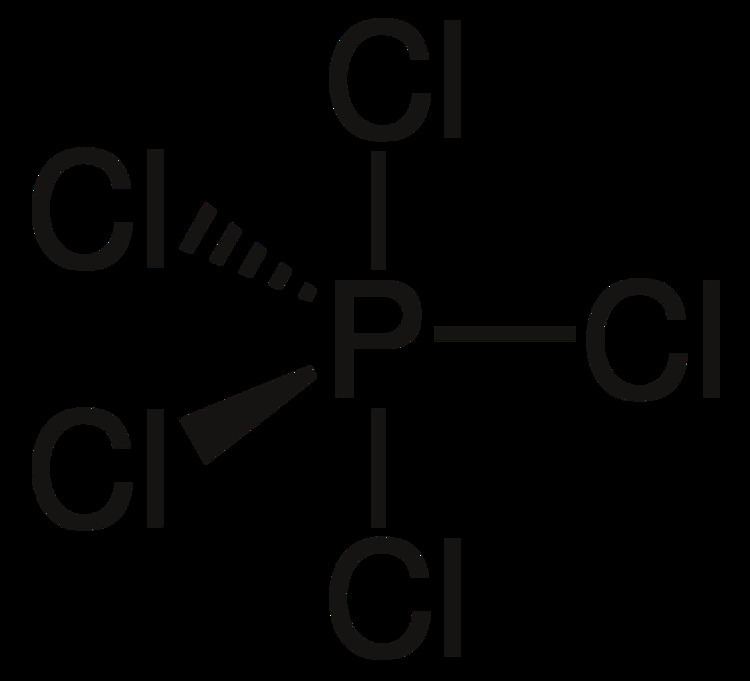
The structures for the phosphorus chlorides are invariably consistent with VSEPR theory. The structure of PCl5 depends on its environment. Gaseous and molten PCl5 is a neutral molecule with trigonal bipyramidal (D3h) symmetry. The hypervalent nature of this species (as well as for PCl−
6, see below) can be explained with the inclusion of non-bonding MOs (Molecular orbital theory) or resonance (Valence bond theory). This trigonal bipyramidal structure persists in non-polar solvents, such as CS2 and CCl4. In the solid state PCl5 is ionic, formulated PCl+
4PCl−
6.
In solutions of polar solvents, PCl5 undergoes "autoionization". Dilute solutions dissociate according to the following equilibrium:
PCl5 ⇌ [PCl+4]Cl−
At higher concentrations, a second equilibrium becomes more prevalent:
2 PCl5 ⇌ [PCl+4][PCl6−]
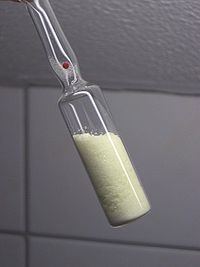
The cation PCl+
4 and the anion PCl−
6 are tetrahedral and octahedral, respectively. At one time, PCl5 in solution was thought to form a dimeric structure, P2Cl10, but this suggestion is not supported by Raman spectroscopic measurements.
Related pentachlorides
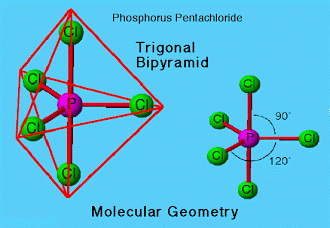
AsCl5 and SbCl5 also adopt trigonal bipyramidal structures. The relevant bond distances are 211 (As-Cleq), 221 (As-Clax), 227 (Sb-Cleq), and 233.3 pm (Sb-Clax ). At low temperatures, SbCl5 converts to the dimer, bioctahedral Sb2Cl10, structurally related to niobium pentachloride.
Preparation
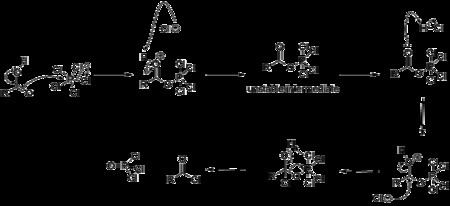
PCl5 is prepared by the chlorination of PCl3. This reaction is used to produce ca. 10,000,000 kg/y of PCl5 (as of 2000).
PCl3 + Cl2 ⇌ PCl5 (ΔH = −124 kJ/mol)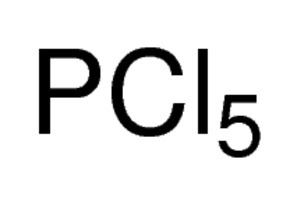
PCl5 exists in equilibrium with PCl3 and chlorine, and at 180 °C the degree of dissociation is ca. 40%. Because of this equilibrium, samples of PCl5 often contain chlorine, which imparts a greenish colouration.
Hydrolysis
In its most characteristic reaction, PCl5 reacts upon contact with water to release hydrogen chloride and give phosphorus oxides. The first hydrolysis product is phosphorus oxychloride:
PCl5 + H2O → POCl3 + 2 HClIn hot water, hydrolysis proceeds completely to ortho-phosphoric acid:
PCl5 + 4 H2O → H3PO4 + 5 HClChlorination of organic compounds
In synthetic chemistry, two classes of chlorination are usually of interest: oxidative chlorinations and substitutive chlorinations. Oxidative chlorinations entail the transfer of Cl2 from the reagent to the substrate. Substitutive chlorinations entail replacement of O or OH groups with chloride. PCl5 can be used for both processes.
Upon treatment with PCl5, carboxylic acids convert to the corresponding acyl chloride. The following mechanism has been proposed:
It also converts alcohols to alkyl chloride. Thionyl chloride is more commonly used in the laboratory because the SO2 is more easily separated from the organic products than is POCl3.
PCl5 reacts with a tertiary amides, such as DMF, to give dimethylchloromethyleneammonium chloride, which is called the Vilsmeier reagent, [(CH3)2NCClH]Cl. More typically, a related salt is generated from the reaction of DMF and POCl3. Such reagents are useful in the preparation of derivatives of benzaldehyde by formylation and for the conversion of C-OH groups into C-Cl groups.
It is especially renowned for the conversion of C=O groups to CCl2 groups. For example, benzophenone and phosphorus pentachloride react to give the diphenyldichloromethane:
(C6H5)2CO + PCl5 → (C6H5)2CCl2 + POCl3The electrophilic character of PCl5 is highlighted by its reaction with styrene to give, after hydrolysis, phosphonic acid derivatives.
Comparison with related reagents
Both PCl3 and PCl5 convert R3COH groups to the chloride R3CCl. The pentachloride is however a source of chlorine in many reactions. It chlorinates allylic and benzylic CH bonds. PCl5 bears a greater resemblance to SO2Cl2, also a source of Cl2. For oxidative chlorinations on the laboratory scale, sulfuryl chloride is often preferred over PCl5 since the gaseous SO2 by-product is readily separated.
Chlorination of inorganic compounds
As for the reactions with organic compounds, the use of PCl5 has been superseded by SO2Cl2. The reaction of phosphorus pentoxide and PCl5 produces POCl3:
6 PCl5 + P4O10 → 10 POCl3PCl5 chlorinates nitrogen dioxide to form nitronium chloride:
PCl5 + 2 NO2 → PCl3 + 2 NO2ClPCl5 is a precursor for lithium hexafluorophosphate, LiPF6, an electrolyte in lithium ion batteries. LiPF
6 is produced by the reaction of PCl
5 with lithium fluoride, with lithium chloride as a side-product:
Safety
PCl5 is a dangerous substance as it reacts violently with water.
